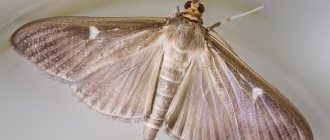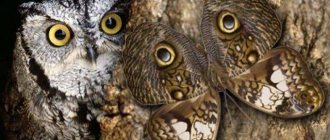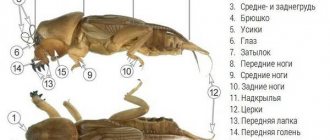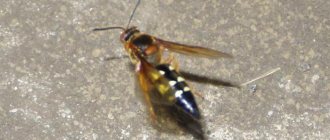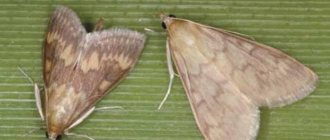Family Features
All female bears are relatively large in size. They have a plump body. The front wings are triangular in shape and in most species are brightly colored. The hind wings are smaller and often have a modest coloration. A calm or resting bear butterfly folds its wings like a house, hiding their brightness.
An important feature shared by the entire family is toxicity. The blood of these butterflies has a bitter taste - this is for those who did not understand the signal of the motley wings and still decided to attack. Most poisonous creatures look striking, as if warning predators about their peculiarity. It is difficult to digest such prey; it can cause irritation in the digestive system or allergies.
Young people are no less protected. Not only does the bear butterfly caterpillar have bitter, poisonous blood, but its hairs also secrete a strong irritant. Not only should you not chew it, but you shouldn’t even touch it. Thanks to this feature, both adult butterflies and caterpillars have virtually no natural enemies.
Lifestyle
The favorite habitats of Callimorphadominula are mixed or sparse deciduous forests. They often settle in bushes, along road ditches, and on the banks of streams. Butterflies become active after dark. During the day they hide in damp, shady places. But there are exceptions to the rules; sometimes adults can be seen during the day, when moths fly over flowers, collecting nectar from umbrella plants.
The moths fly in June-July. The species is sedentary; males and females do not spend much time looking for a partner.
After mating, eggs are laid on the main food plants of the caterpillars:
- stinging nettle;
- jasmine;
- buttercup;
- geranium.
There are several subspecies of Callimorphadominula living in Europe and Asia:
- C. d. philippsi – Azerbaijan, northern Iran;
- C. d. rossica – Caucasus. Transcaucasia;
- CD persona – Italy.
These are just a few subspecies. Also interesting is the yellow form of the female bear f. flava.
Defense mechanism
The species has a weak flight, so catching a moth is not difficult. At the same time, they do not have many natural enemies. This is due to the presence of poison in the body of insects. The hemolymph of the imago is bitter; not many birds and reptiles like it. The protective mechanism is present not only in adult representatives of the species, but also in larvae. Long and thick hairs are a decoration, and a kind of shield from predators. Even in humans, they can cause an allergic reaction if you frighten the caterpillar by picking it up.
Caterpillar
Before turning into butterflies, caterpillars have to do a lot of work and perform an important task - to eat for future use. Therefore, they are omnivorous and gluttonous. Caterpillars eat shrubs and herbaceous plants, and tree foliage. This harms the plants.
Before pupation, the caterpillar spins a loose, silky cocoon. She weaves her own fallen hairs into the walls. The pupa inside the cocoon is motionless.
Lady bear
In the middle zone, the lady bear butterfly is very common. It is quite large, its wingspan reaches 5.5 cm.
These butterflies live in shady and damp places in June and July. They inhabit ravines, river banks, forest glades and clearings. Caterpillars eat leaves of shrubs and herbaceous plants: willow, blackberry, strawberry. Pupation occurs in the spring.
Types of mole crickets, photos and names
Medvedkas hardly differ from each other in appearance and lifestyle. Some can be distinguished from each other only by the number of chromosomes.
According to the latest research and information presented on the website orthoptera.speciesfile.org, the Far Eastern mole cricket (lat. Gryllotalpa fossor) is synonymous with the African mole cricket (lat. Gryllotalpa africana).
Below is a description of several varieties of mole crickets.
- Common mole cricket (lat. Gryllotalpa gryllotalpa)
Widespread species. The body size of the insect reaches 3.5-5 cm, the length of the pronotum is 1.2-1.6 cm, the elytra is 1.3-2.1 cm, the hind femur is 1-1.3 cm. The body is dark brown, with lighter, brownish-yellow abdomen, covered with dense small hairs. The head and back are almost black. The abdomen is yellowish or olive in color.
Widely distributed in Europe, except Scandinavian countries. The common mole cricket also lives in Russia, North Africa and some areas of Asia: Transcaucasia, Asia Minor and Western Asia, the Middle East, Iran, Kazakhstan.
Photo credit: Tobias b köhler, CC BY-SA 3.0
- African mole cricket (eastern mole cricket) (lat. Gryllotalpa africana)
It has smaller dimensions than the common mole cricket: the body is 2.0-3.5 cm, the length of the pronotum is 0.6-0.9 cm, the length of the elytra is 0.8-1.2 cm. The color is brown-yellow above and yellow below.
African mole crickets live in Central, South and Southeast Asia, on the Japanese and Philippine Islands, Ceylon and Madagascar, Korea, the Russian Far East, Australia, New Zealand, and in the tropics and subtropics of Africa.
Photo credit: Bernard DUPONT, CC BY-SA 2.0
- Ten-toed mole cricket (lat. Neocurtilla hexadactyla)
A variety characterized by its small size: from 1.9 to 3.3 cm in length. Initially, these mole crickets inhabited North and Central America, and from there they settled into South America.
Photo credit: dogtooth77, CC BY-NC-SA
- Steppe mole cricket (lat. Gryllotalpa stepposa)
It is a morphological double of the common mole cricket, that is, it is absolutely similar in appearance. The length of the insect reaches 4-5.4 cm. The body color is brown-yellow.
The habitat of the mole cricket is Moldova, the south of Ukraine, the Southern District of Russia and the south of Turkmenistan.
Photo by: Lubomír Klátil
- Single-thorn mole cricket (lat. Gryllotalpa unispina)
The body length of the insect varies from 3.8 to 4.4 cm, the length of the oval pronotum is 1.1-1.3 cm, the elytra is 1.5-1.7 cm. The body structure, lifestyle, nutrition and reproduction of this insect are characteristic for the whole family, like the brownish-yellow color.
It is a halophile, that is, it is found on saline soils along the shores of seas and lakes, as well as on wet salt marshes. Single-spined mole crickets live in the south of Moldova and Ukraine, in the Lower Volga region of Russia and the Rostov region, in Crimea, Georgia, Azerbaijan, Armenia, Kazakhstan, Uzbekistan, Turkmenistan, Kyrgyzstan, Tajikistan, Iran, Afghanistan and China. Its habitat may change depending on the distribution of salt marshes and solonetzes.
Author of the photo: Danilov Yu.N.
Kaya bear
No less common is the moth, the bear kaya. Representatives of the species are very beautiful. The wingspan of up to 8 cm makes them one of the largest in our country.
The fore wings of the female bear kaya are coffee brown, with white constrictions. On the rear red wings there are large black and blue peas.
Kaya bears live in late summer. Their black, furry caterpillars emerge in the fall, survive the winter, and transform into butterflies in the summer. At the moment of danger, the caterpillars curl up into a ring, protecting all their important organs, exposing their poisonous hairs. Caterpillars weave their cocoons under snags and fallen tree trunks.
Description
Wingspan 50-80 mm. The length of the fore wing is 25–33 mm. The color of the upper side of the wings is brown-white with an irregular sinuous pattern, characterized by great variability. The upper side of the hind wings is light red with five large round spots, the color of which varies from black to bluish. The head and chest are dark, red-brown, the abdomen is red, with black transverse stripes. Butterflies are different. Each individual has an individual pattern on the upper side of the wings. The upper side of the hind wings may be red or yellow, with many or no spots, or plain black.
In individuals developing under the same conditions, color variability is sometimes observed, and sometimes these differences are so great that butterflies can be mistaken for representatives of different species.
American polar bear
The beautiful snow-white hairy-headed bear butterfly is actually a formidable pest for agriculture and forestry. This species, originally from North America, came to Europe in the middle of the last century, from where it spread across Ukraine, southern and western Russia, and penetrated into Turkmenistan and other countries of the Middle East. Experts believe that this could not have happened due to natural reasons and the butterflies came to the mainland with cargo transported across the Atlantic.
The white moth, as this butterfly is sometimes called, is of medium size, its wingspan does not exceed 3.6 cm. Environmentalists and the quarantine service are taking measures to prevent the further spread of this pest.
Medvedka description and photo. What does a bear look like?
Mole crickets are large insects. The length of their body varies from 3.5 to 5 cm, and the thickness reaches 1.2-1.5 cm. The body of the cabbage plant is colored silky brownish-brown on top, and brownish-yellow on the bottom. The insect's body is covered with tiny hairs.
Photo credit: Natasha Wright, Cook's Pest Control, Bugwood.org
The head of the mole cricket has a prognathic, or straight, position in relation to the body. Its axis coincides with the axis of the body, and the oral organs, which are powerful jaws, are directed forward.
Near the jaws there are 2 pairs of tentacles.
Photo by: Frank Dorsman
The large, clearly visible eyes of the mole cricket have a facet structure and are located on the sides of the head.
Thread-like antennae grow on the head of the insect, slightly extending beyond the pronotum. They are shorter compared to the whiskers of other representatives of crickets.
Photo credit: Katpatuka, FAL
The large and flat pronotum of the mole cricket with the lateral parts (blades) hanging down is a distinctive feature of the insect. The midthorax and metathorax of the insect are connected. The head and front part of the animal's body are covered with a dense chitinous shell - a device for pushing and compacting the earth when digging holes. Because of this shell, the mole cricket resembles a crayfish.
The abdomen of the cabbage plant is thick, reaching 1 cm in diameter, consists of 10 tergites and 8-9 sternites. The apex of the abdomen has anal and genital plates. Females do not have an ovipositor. The last segment of the abdomen has long, flexible cerci, or caudal appendages, covered with small hairs, resembling antennae in appearance.
Photo credit: Clemens Stockner, CC BY-SA 3.0
Mole crickets have 2 pairs of wings:
- The forewings are transformed into short and leathery elytra, covered with thick veins. In length they reach only the middle of the abdomen. The left elytra of insects from the cricket superfamily is always covered by the right one.
- The hind pair are long, wide, transparent, membranous wings with fine venation. In a calm state, they are folded like a fan under the elytra and extended along the abdomen in the form of cords. During the flight of an insect, the hind wings take an active part, while the elytra are involved to a limited extent.
Males differ from females in the venation of their elytra. There are also wingless individuals of both sexes, but they are less common. By the way, the larvae do not have wings.
Photo by: George Chernilevsky, Public Domain
The mole cricket has 3 pairs of limbs, each of which consists of a coxa, trochanter, femur, tibia and a 3-segmented tarsus.
By the way, the auditory apparatus (or organ of hearing) of the mole cricket, like that of many other chirping orthoptera insects (grasshoppers, crickets), is located on the shins of the forelimbs and has an oval or narrow slit-like shape.
The hind legs of the insect are strong and designed for movement; there are 1-4 spines on their inner side. The claw-like forelimbs are a digging apparatus. The thigh and lower leg are greatly expanded, and the tarsus is shortened. On the shin there are 4, and on the tarsus there are 2 black spike-like teeth, with which the mole cricket crashes into the ground.
There are auditory openings on the front legs of the mole cricket. They have an oval or narrow-slit shape.
Photo by: Pavel Korzunovich (PaKor)
Grim Cave Butterfly
The Transcaspian gloomy bear is a very unusual butterfly. It owes its name to both its unprepossessing appearance and lifestyle. This insect spends most of its life on the walls of caves and the stalactites growing on them. At night, this butterfly emerges from its hiding place and often flies up to tourist sites, attracted by the light of fires. It is noteworthy that caterpillars and pupae live far from caves, preferring steppes covered with wormwood and forbs.
This species is still poorly studied. And other representatives of the bear butterfly family keep many secrets.




